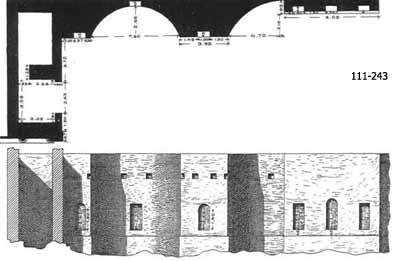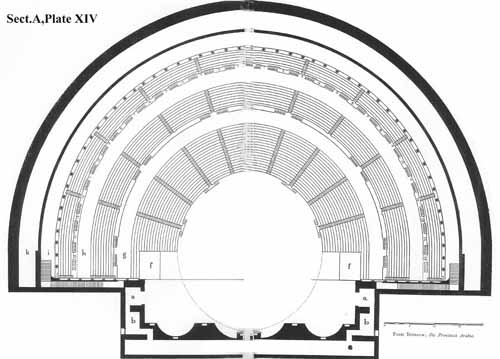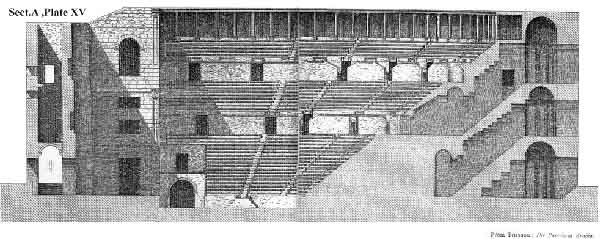|









|
|
Theatre
|
The Theatre of Bostra is the
building above all others that has attracted the notice of
travellers and of archaeologists. It is moreover the best preserved
Roman theatre in existence, with the sole exception of that at
Aspendos in Asia Minor; yet, owing to the fact that it was
completely enclosed without in the mighty redouts of an Arabic
fortress of the 13th century, and filled within with the vaults and
chambers of that same castle, it is much less easy to see, or to
study, than many theatres of its period that are far less well
preserved. Every visitor to Bosra who has published any account of
his travels has given some space to a description of this
extraordinary building which is at once Classical and Mediaeval, and
is today the post of a small Turkish garrison. Some of the earlier
travellers failed to recognize the ancient purpose of the building,
the descriptions of others are far from satisfactory. M. Rey
published a cross section of it, 'M. de Vogue gives a perspective
sketch; while many others present views of greater or less interest.
It remained for Professor Brunnow 3 to make the first exhaustive
study of the theatre, and to publish a full, accurate, and
satisfactory account of the building, with ample plans and other
measurements drawn to scale and with illuminating photographic
illustrations. It would be impossible to make a more complete survey
of the ruin without removing the walls and vaults of the Arabic
castle from the interior, and even such a laborious undertaking
would serve probably only to justify the conjectures presented in
the plans of Professor Brunnow. |
|
|
| Confident that the possibilities of the Theatre had
been. exhausted, I did not undertake a thorough examination of the
building beyond verifying the accuracy of the details of a number of
proofs of drawings which Professor Brunnow had sent me. I have been
so fortunate as to secure permission to republish herewith some of
the more general plans which appeared in Die Provincia Arabia, and
these, with two photographs of my own, will serve to illustrate the
brief account here given. For further details 1 may refer the reader
to the excellent publication cited above. |
|
It should be explained that my two
photographs (Ills. 241-242) show only the uppermost parts of
the Theatre, the highest ranges of seats, the colonnade above
the top row, and the very summit of the walls which flank the
stage building, i. e. the uppermost third of that wall which
is ih reality somewhat over 20 metres high, the remaining two
thirds being hidden by the constructions of the 13th century.
The relation between the two ends of the stage building
represented in the photographs is perfectly shown in Brunnow's
Fig. 929. 111. 243, also reproduced from Die Provincia Arabia,
shows a plan and the upper part of the elevation of the stage
building. |
 |
|
|
The Theatre of Bostra was not excavated in the
side of a hill in the manner of Greek theatres, or like the Roman
theatre of Philadelphia ('Amman) which may have had a Greek
predecessor; but was a massive structure of masonry entirely built
up on comparatively level ground, like the Theatre of Marcellus in
Rome.
It consisted of a high and heavy semicircular wall which bounded and
supported the cavea, and a straight wall of lighter construction
which terminated the ends of the seats and broke out to enclose the
rectangular stage building (PI. XIV). The entire space between the
upright curving wall of the cavea and the slanting tiers of seats
was penetrated in all directions with vaulted passages and
staircases which provided direct and easy access to all parts of the
cavea, and incidentally lightened the structure. A very good idea of
these vaulted passages may be had by reference to the transverse
section of the building reprinted from Brunnow's publication (PI.
XV). |
|
|
|
In comparing this theatre with the one at
Philadelphia one may say, aside from the consideration that the one
is built up and the other excavated, that in extreme width they are
of about equal dimensions, and that, on general lines, the ground
plans are very similar. The semicircle of the orchestra has a
greater diameter at Bostra, but the cavea here is lower and the
number of tiers of seats is less by sixteen, and consequently
affords a far smaller seating capacity. This is due in part to the
fact that the cavea at Philadelphia is not only higher, but steeper,
because the horizontal aisles {praecinctiones) are much narrower,
though the seats have similar dimensions in both theatres. There is
little ground for a comparison of ornamental details since the whole
of the stage building and the upper colonnade are missing in
Philadelphia; but one does not fail to observe that the mouldings
which enrich the seats are more elaborate in the Theatre at Bostra.
The arch mouldings and pilaster caps are similar.
We have really no criteria by which either of these theatres may be
dated, but it is natural to assume that the Theatre at Bostra was
built rather soon after the formation of the Province of Arabia, and
perhaps in connexion with the increased importance of the
Dushara-Dionysos cult under the early Antonine Emperors.
Dr. Littmann discovered in the Theatre a broken panel of a parapet
with a Nabataean inscription upon it. Such a parapet might very well
have belonged to the balcony, or private loge, which Brunnow has
reconstructed at (f) in his plan. This, if assumed to be true, would
give an early date to the building . |
|

|
|

|
|
